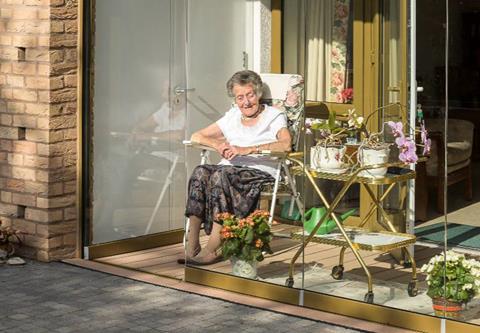Covid-19 has laid bare how problematic a care home setting can be, but there are ways to rethink spaces and improve lives, says PRP’s Anne-Marie Nicholson

We have undeniably failed to shelter our social-care sector and our elderly since the beginning of the coronavirus crisis. The steep numbers published by the ONS in May are there to remind us of what we have lost and still have to lose.
But despite the reality of so many of our care homes throughout the pandemic the future does not have to be as bleak as the past.
In the face of coronavirus, it is time to carefully rethink how we design care-homes to safeguard our elderly from future pandemics and enable them to lead less isolated and better supported lives. At the same time, we need to ensure that other models of housing with care options are available.
Some design ideas will come at an additional cost to providers and developers but others are just about applying some common sense.
Bringing the outside in

Care homes designed to bring the benefits of the outdoors indoors give people happier, healthier lives. Studies have found that even activities as simple as looking at natural scenes such as clouds moving across the sky or leaves rustling in the breeze can have a restorative effect on the brain.
Improving natural light and ventilation can play a major role in bringing the outside in but must often be balanced against the need for safety when it comes to designing care homes. A simple solution would then be to remove window restrictors and replace them with secure external louvres. Residents would then benefit from wider window openings and fresh air.
Including more private, or shared balconies, at the design-stage would also make a real difference for those isolating on the upper floors.
Including more private, or shared balconies, at the design-stage would also make a real difference for those isolating on the upper floors
The outdoor spaces will also need to be redesigned to facilitate social distancing in the future. Landscape gardens, an essential component of any care-home, will now need to be large enough to include planned seating areas, in a curve perhaps, and covered areas so families can visit whether it rains or shine.
Rethink the internal space

We will need to rearrange internal spaces to create a real separation between operational activities and residents. One way of achieving this would be to design separate entrances for deliveries and staff to limit interaction.
In communal areas, this would mean installing programmable automatic doors to limit the need to touch.
We also need to think about designing larger and more widespread storage facilities for PPE as well as medical and cleaning equipment, and include hand-washing facilities in key locations.
Accommodation floors will have to be designed in a way to avoid pairing of doors. Bedroom doors could be fitted with windows, with integral blinds, so that isolated residents can have visual contact with others.
Only 10% of local authorities in the UK have a specific policy in place to address housing for older people despite government guidance
Finally, communication technology has been a real lifeline for many throughout the pandemic and we should seriously consider installing these technologies into residents’ homes so they can maintain links with relatives, friends and the staff in the care home.
Redefining community
Covid-19 has laid bare just how problematic a care home setting can be, if we want to make truly meaningful changes we might have to rethink the entire care offer for our older generation, and that is where intergenerational housing comes in. We see a real future where populations of all ages live together in a blended community environment.
Our older population can no longer be the forgotten generation of our future communities. We urge town planners and local authorities to seriously think about including intergenerational communities as well as care homes in their local plans.
Only 10% of local authorities in the UK have a specific policy in place to address housing for older people despite government guidance.
This would keep friendships and families alive as a viable and alternative setting for some of the 440,000 people in care homes while giving us the opportunity to design high dependency care homes the best we can for those that really need them.
Anne-Marie Nicholson, partner at PR



























No comments yet